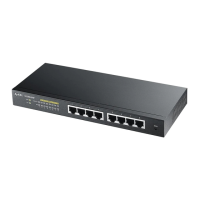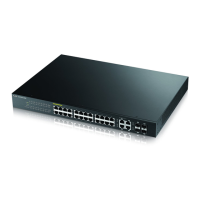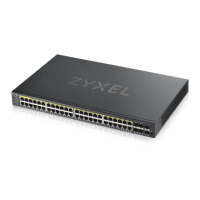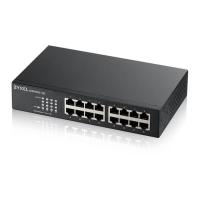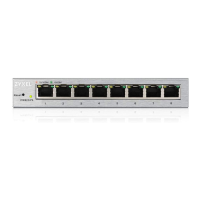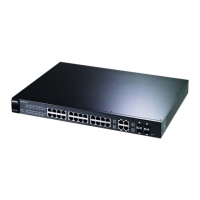
Do you have a question about the ZyXEL Communications GS1500-24P and is the answer not in the manual?
| Ports | 24 |
|---|---|
| PoE Ports | 24 |
| Switching Capacity | 52 Gbps |
| MAC Address Table | 8K |
| Jumbo Frame | 9K |
| Storage Temperature | -40°C to 70°C |
| Dimensions (W x D x H) | 44 mm |
| Operating Temperature | 0°C to 50°C |
| Humidity | 10% to 90% (non-condensing) |
| Power Supply | Internal |
Manual is for users configuring the Switch via web interface.
Guides users to website resources like Download Library and Knowledge Base.
Details how to contact vendor or ZyXEL for support issues.
Explains symbols for warnings and notes used in the guide.
Defines text formatting, key strokes, and notation used in the manual.
Lists safety precautions for using the product to avoid hazards.
Introduces chapter features and applications of the Switch.
Describes Backbone, Bridging, High Performance, and VLAN examples.
Explains placing the Switch on a desktop or in a rack.
Step-by-step guide for desktop installation of the Switch.
Instructions for mounting the Switch in a standard EIA rack.
Details the front panel of the Switch, including ports and LEDs.
Describes SFP slots for transceivers and their installation.
Explains the RESET button, rear panel, power connector, and LEDs.
Steps to start the web browser and access the Switch login page.
Describes the initial screen after login and its components.
Recommends password change and warns about lockout actions.
Explains how to reset the Switch and log out for security.
Explains confining broadcast frames to a VLAN group.
Details using PVID to tag incoming untagged frames for VLAN forwarding.
Explains how to change the default management IP address.
Displays general Switch information like firmware version and MAC address.
Configures system time and the Switch IP address/gateway.
Configures web configurator login details and Switch port settings.
Explains logically aggregating links for higher bandwidth and STP/LACP.
Describes assigning ports to trunk groups and configuring distribution algorithms.
Details LACP configuration and provides a static trunking example.
Explains VLANs, tagging, forwarding, and terminology.
Describes configuring static VLANs and port VLAN IDs (PVIDs).
Explains STP's role in preventing network loops and defines key terms.
Explains how STP works and describes port states (Disabled, Blocking, etc.).
Details configuring global STP modes and individual port settings.
Introduces QoS, traffic prioritization, and DiffServ concepts.
Maps DSCP values to priorities and configures policy-based rules.
Explains SPQ, WFQ, and WRR algorithms for managing network congestion.
Discusses port-based and policy-based mirroring setup.
Details selecting mirror ports and configuring traffic for examination.
Explains SNMP protocol and configuring basic settings.
Covers SNMPv3 for enhanced security with groups and users.
Lists supported Management Information Bases (MIBs) and trap types.
Introduces configuring traffic rate limits for maximum allowable bandwidth.
Details adding or modifying rate limit policies for traffic flows.
Introduces capping maximum bandwidth and configuring Jumbo Frames.
Explains how to limit bandwidth for incoming and outgoing traffic.
Configures the maximum size for Jumbo Frames.
Introduces PoE support and configuring power allocation to devices.
Explains MAC forwarding tables and static MAC address forwarding.
Details configuring static MAC entries and MAC filtering rules.
Introduces 802.1x authentication and the RADIUS server process.
Details activating 802.1x security and configuring RADIUS server parameters.
Explains ARP, ARP table entries, and inspection overview.
Configures dynamic ARP settings and static MAC-IP bindings.
Enables ARP validation checks based on VLAN ranges.
Introduces storm control and configuring packet rate limits per port.
Introduces the Defence Engine to protect the CPU from traffic floods.
Explains logging and port statistics for monitoring Switch events.
Configures logging settings and displays Switch logs.
Displays port statistics like link status and packet counts.
Explains configuring screens for firmware and configuration file maintenance.
Details backing up/restoring configurations and upgrading firmware via TFTP.
Explains how to reset to factory defaults and restart the Switch.
Addresses issues related to power, connections, and LED behavior.
Troubleshooting steps for accessing or logging into the Switch.
Instructions for safely removing and installing a fuse.
Provides copyright notice, liability disclaimer, and trademark information.
Details FCC, CE, BSMI warnings, and laser product information.
Details the product warranty terms and registration process.
Presents the license agreement terms for the product's software.
Outlines software usage restrictions, ownership, and warranty disclaimers.
